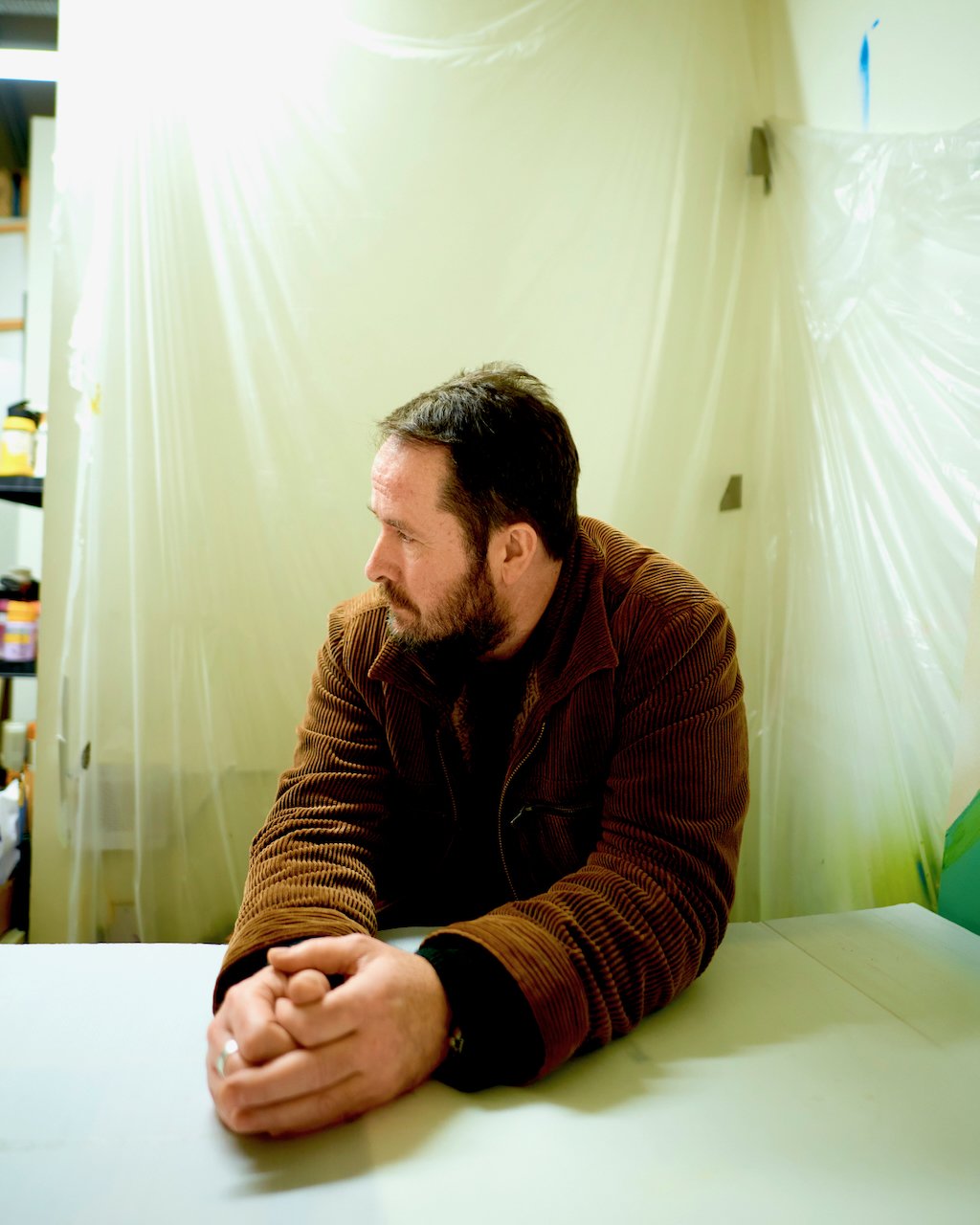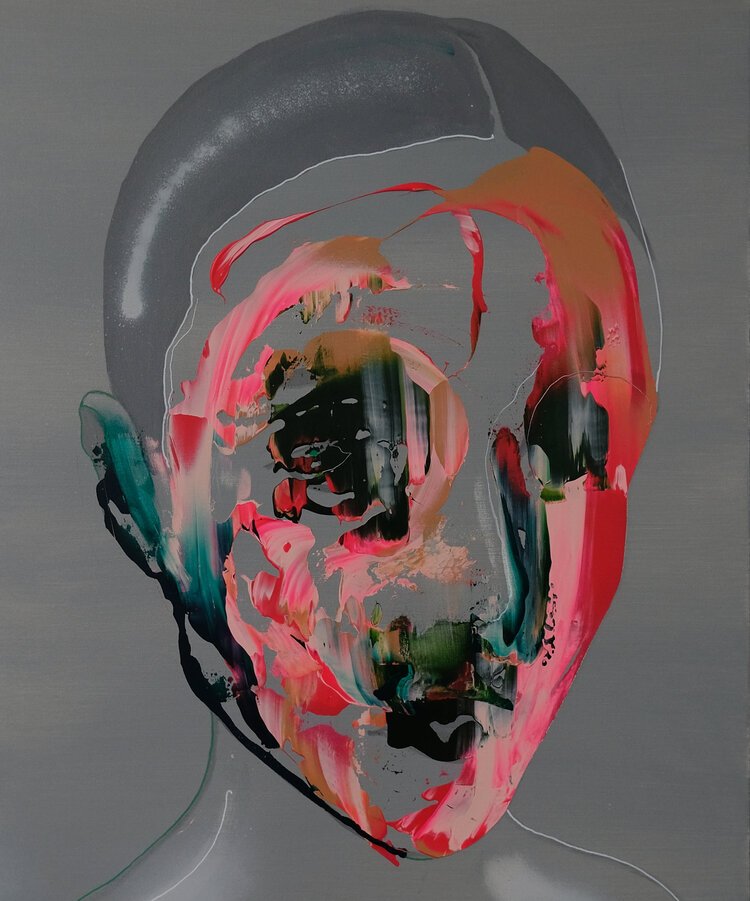Rhiannon Roberts in Conversation with Artist Warren King
Shortlisted for the Emerge and New Emergence Art Prizes in 2018 and 2020 and a Turner Contemporary Open 2021 Winner, West London based artist Warren King is known for painting characters that exist in a state of mid-metamorphosis. Brimming with colour and chaotic energy, his work is rooted in his upbringing in Belfast during the Irish Troubles and consequent fixation on horror films.
Fascinated by faith in the intangible and the willingness to die for what one believes in, King aims to capture this physical and spiritual journey to paradise through his semi-abstracted figures and hazy landscapes.
Following his most recent solo exhibition at Pringle of Scotland in Mayfair, we sat down to discuss early influences, escaping corporate life, and why he rarely uses a paintbrush.
King in his West London studio.
“Finding a favourite is an impetus behind every artist–always looking for that truly amazing piece.”
Rhiannon Roberts: You grew up during the Troubles in Northern Ireland. How did this contribute to the ways you viewed or created art? Does it still affect your practice today?
Warren King: I was always drawing and sketching as a boy, and as I got older and after being exposed to more and more violence, this started to manifest itself in my pictures. It ran parallel with me developing a huge fixation on horror films like Werewolf, Dracula, and Frankenstein–and in turn, my paintings were gruesomely violent horror images featuring decapitated heads and huge arcs of spurting blood. I found out recently that a woman who had offered to adopt me secretly took all my pictures to show to a leading child psychiatrist because she was worried about how disturbing the images were. I’ve calmed down a lot since then but I still love horror and the darker side of life and I think that comes out in many of my paintings.
RR: You later studied graphic design at Medway Art School. How did that influence your practice?
WK: I love bold, bright colours contrasted against dark tones. I took a graphic design course at an HND level, which I failed–I always felt like a fine artist committing myself to the wrong discipline–but aspects of my time at the Medway Art School definitely left an impression on me. I love clean, clear lines merging with more chaotic shapes and patterns–so I guess there’s an ongoing struggle in my mind between chaos and order!
RR: You committed to painting full-time in 2016. What prompted you to take that leap?
WK: I had worked in offices all of my adult life, sat in front of a computer feeling bored and unhappy. To escape that sensation, I started drawing again and it suddenly clicked that I only ever felt happy when I was being creative–which the office jobs never offered me–so I took a huge leap of faith and decided to become an artist full time.
Warren King, St Lucia. Acrylic on canvas, 91 x 121 cm.
RR: Your portraiture is wonderfully distinctive and explores the in-between space between contemporary portraiture and pure abstraction. Who are your biggest influences and how did you develop your signature style?
WK: Obviously Francis Bacon casts a huge shadow over any artist attempting to produce semi-abstract, figurative paintings–his work still looks so goddamn fresh and exciting. The Romanian artist Adrian Ghenie has been described as a modern Bacon and I love his palette choices and wonderful imagination. In terms of developing my skill, I owe a lot to Gerhard Richter. I rarely use paintbrushes, and after watching videos of how he applied paint, I took to using DIY plastic scrapers to push and pull the paint. After a while, I got quite good at working angles so that something resembling a face started to appear in my efforts.
RR: What is your process like from start to finish on an artwork?
WK: I use a projector, initially, to get a good head shape on the canvas, then I build up layer upon layer of paint endlessly until, if I’m lucky, something begins to emerge in front of me that I’m happy with. Masking sheets help to subdivide sections of the canvas and break down components that I want to concentrate on. It sounds technical, but chaos and intuition kick in if I feel the painting is becoming too contrived.
RR: You said you rarely use paintbrushes. How important are your materials to your process? Can you talk more about what you like to work with and why?
WK: Scrapers are vital to how I work. Because of their shape, they’re awkward and clumsy to use, which is perfect because they stop me from getting bogged down in portrait details and always means that it is my imagination that conjures up a face and not a brush. I leave that type of portraiture to artists who want to capture the physical aspects of a person–I’m more interested in capturing the turmoil within.
RR: Your use of colour is particularly interesting and causes every portrait to evoke a different range of emotions. Can you talk more about the role colour plays in your work?
WK: I’ve always been drawn to chiaroscuro–the use of strong contrasts between light and dark–which Caravaggio was so adept at. I apply that principle to colours too. Vibrant, fluorescent red and pink really contrast beautifully when put up against darker tones and it’s also a nice and slightly obvious metaphor for the battle between light and dark within the soul.
RR: I was interested to learn that you also paint landscapes. How does your process with landscape painting differ from that of your portraiture?
WK: I enjoy landscape painting. For me, it’s a mental holiday from my normal work. As I use paintbrushes to do them, I become much more traditional in my thought processes. I love Turner as an artist and think his landscapes still look incredibly fresh and exciting and I enjoy producing broody, cloud-filled skies on the brink of obscuring the sun.
RR: Your work Woman With a New Hat, which sold to a private collector long before, was recently recognised and exhibited at the Turner Contemporary Open 2021 in Margate, Kent. How did you feel when you first heard the news?
WK: I was initially incredibly excited, but then after a short correspondence with the gallery I was a little disappointed, as it became clear I was one of 400 winners! However, after going to the exhibition, I was very humbled as I realised that many of the other artists on show, not least Tracey Emin, are all much better than me. I ended up feeling very grateful and flattered to have been one of the artists chosen. The work has only just been reunited with its owner.
Warren King, Lucy. Acrylic on canvas, 130 x 150 cm.
RR: You recently exhibited at Artemesia Galerie in Denver, Colorado, USA, and Pringle of Scotland’s Mayfair boutique in London. What’s up next for you?
WK: I’ve got a one night show at John Birchall on Columbia Road in East London on 22 April and Artists At Home in June for three days where my home is open for anyone to come in and look at my work.
RR: Where do you hope to be in five years?
WK: My only interest is improving and getting better. I’m tempted to say I want everyone in the art world to be aware of me, but getting better is always my main goal!
Thanks to Warren King on behalf of MADE IN BED.
Rhiannon Roberts
Editor In Chief, MADE IN BED













